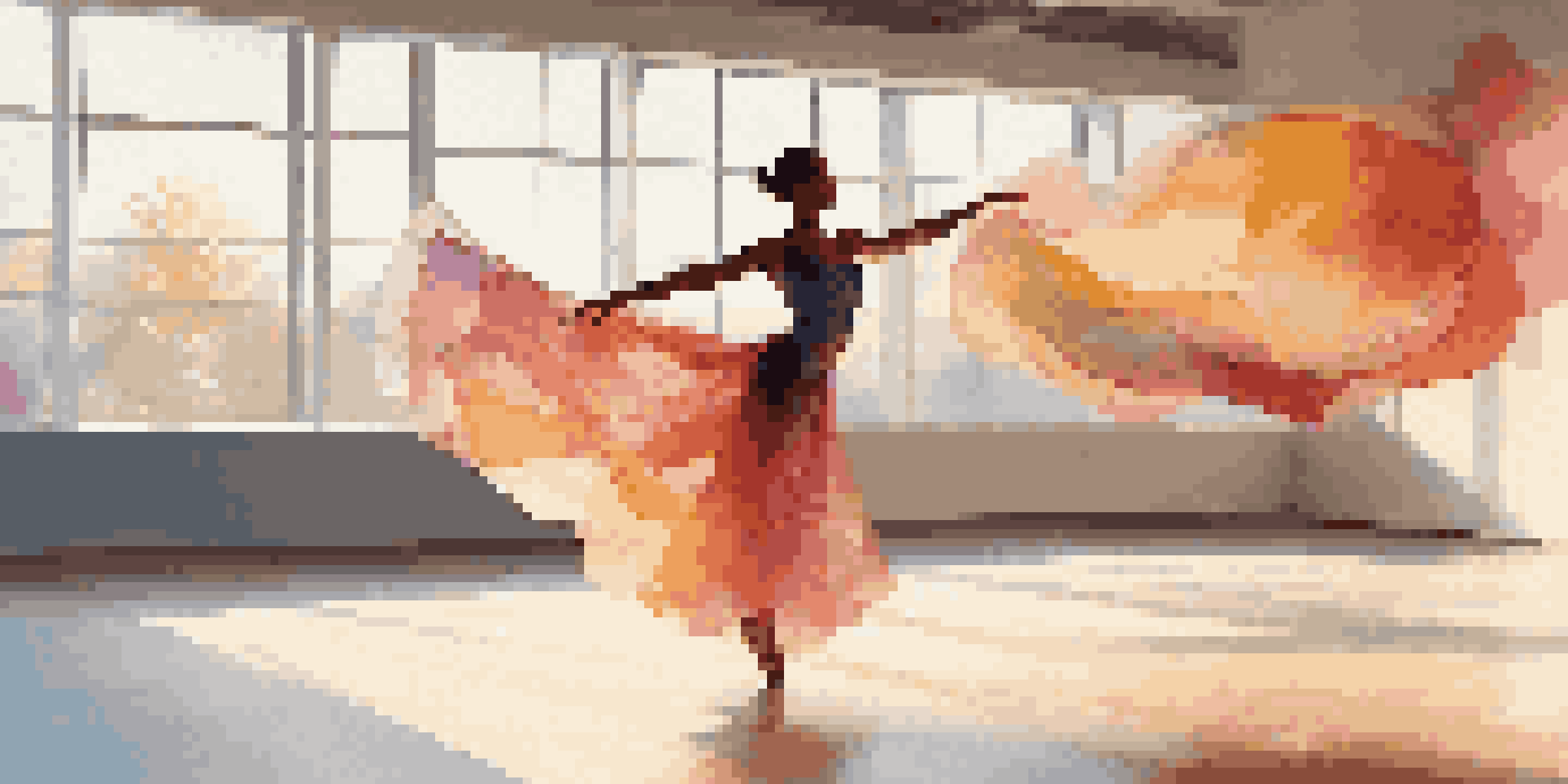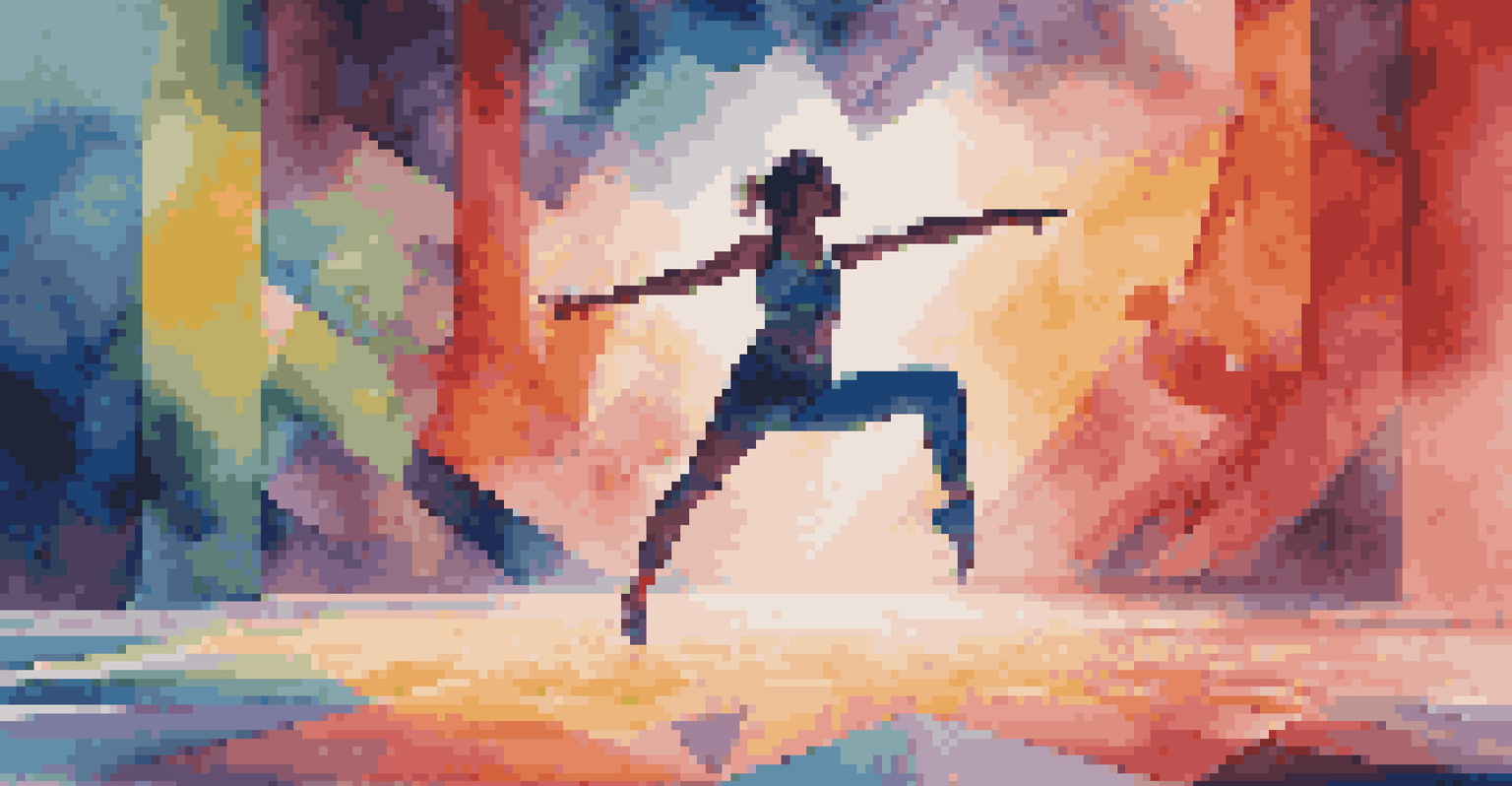The Relationship Between Dance and Digital Art Innovations

The Intersection of Movement and Technology
Dance has always been a form of expression, a way to tell stories through movement. With the rise of digital art, this expression is reaching new heights, leveraging technology to enhance performances and create immersive experiences. Think of how a dancer's movements can be captured and transformed into mesmerizing visual displays through projection mapping or augmented reality.
Dance is the hidden language of the soul.
This fusion allows artists to explore new dimensions in their work, pushing the boundaries of traditional choreography. Imagine a performance where the dancer is not just moving through space but also interacting with stunning visuals that respond to their every step. This interplay creates a dynamic relationship between the dancer and the digital canvas, enriching the overall experience for the audience.
Moreover, the collaboration between dancers and digital artists gives rise to innovative performances that challenge the status quo. The potential for storytelling expands dramatically as technology provides tools for deeper engagement and emotional impact, making the viewer feel as if they are part of the narrative.
Digital Tools Transforming Dance Choreography
Choreographers are now using digital tools such as motion capture and animation software to create and refine their dances. These technologies allow them to visualize movements in a way that was previously impossible, enabling them to see how their choreography flows in relation to digital scenery or effects. By seeing their ideas come to life in real-time, choreographers can make adjustments and experiment with new concepts.

For example, motion capture can track a dancer's movements and translate them into animated characters or visual graphics. This process not only aids in the creation of new choreography but also opens up opportunities for collaboration with tech-savvy artists who specialize in digital storytelling. It’s a collaborative effort that combines the physicality of dance with the limitless possibilities of technology.
Dance Meets Digital Innovation
The integration of technology enhances dance performances, creating immersive experiences that transform audience engagement.
As a result, we are witnessing a significant evolution in how dance is created and performed. This integration of technology fosters creativity and encourages dancers to explore new styles and genres, ultimately enriching the art form.
Immersive Experiences in Dance Performances
The advent of virtual reality (VR) and augmented reality (AR) has transformed how audiences experience dance. These technologies create immersive environments where viewers can feel as though they are part of the performance, rather than just spectators. Imagine donning a VR headset and being transported to a digital world where dancers move fluidly through stunning landscapes, interacting with elements that change based on the choreography.
Technology is best when it brings people together.
Such immersive experiences deepen the emotional connection between the audience and the performers. It allows viewers to engage with the narrative on a personal level, feeling the rhythm and energy of the dance as if they were dancing alongside the artists. This level of engagement can lead to a more impactful and memorable experience.
Furthermore, these innovations provide opportunities for artists to reach wider audiences. With digital platforms, performances can be streamed globally, allowing people from different backgrounds and locations to experience the beauty of dance like never before.
The Role of Social Media in Dance and Digital Art
Social media has become a powerful tool for dancers and digital artists to showcase their work. Platforms like Instagram and TikTok allow artists to share short performance clips, often enhanced with digital effects, reaching audiences far beyond traditional venues. This democratization of art means that talented individuals can gain recognition without needing to go through conventional channels.
These platforms not only serve as a stage for artists but also foster community engagement. Dancers can connect with fans and fellow creators, sharing ideas and collaborating on projects that blend dance with digital art. The viral nature of social media challenges artists to innovate and create captivating content that resonates with viewers.
Choreography Transformed by Tech
Digital tools like motion capture allow choreographers to visualize and refine their work, leading to innovative collaborations.
Moreover, social media trends often influence choreography, leading to the emergence of new styles and movements that reflect contemporary culture. As artists respond to these trends, they continue to bridge the gap between dance and digital art, creating a vibrant, ever-evolving landscape.
Educational Opportunities in Dance and Digital Art
Educational institutions are increasingly recognizing the importance of integrating digital art into dance curricula. Dance programs are beginning to include courses on digital technology, preparing students for a future where these skills are essential. This shift in education encourages dancers to think beyond traditional methods and embrace a multidisciplinary approach.
For instance, students might learn about video editing, motion graphics, and even coding, empowering them to create their own digital content. This skillset not only enhances their artistic capabilities but also opens up career opportunities in a variety of fields, including performance art, multimedia production, and digital marketing.
As students gain experience with digital tools, they become more versatile artists capable of navigating the complexities of modern performance. This educational evolution ensures that the next generation of dancers is well-equipped to thrive in an increasingly digital world.
Challenging Traditional Norms in Dance
The integration of digital art in dance is also challenging traditional norms and expectations. Artists are exploring new forms of expression that defy conventional boundaries, leading to innovative performances that blend various genres and styles. This evolution encourages both dancers and audiences to rethink what dance can be, opening the door for more inclusive and diverse representations.
For example, some performances now incorporate elements of video game design, where dancers interact with a virtual environment that evolves based on their movements. This not only adds a layer of complexity to the choreography but also invites audiences to engage with the performance in unique ways. It challenges the idea of dance as a strictly physical art form, revealing its potential as a multidimensional experience.
Social Media Shapes Dance Culture
Platforms like Instagram and TikTok empower dancers to showcase their art, fostering community and influencing contemporary styles.
As artists continue to push these boundaries, they pave the way for new conversations around identity, culture, and creativity in dance. This shift encourages a more expansive understanding of what it means to be a dancer in the digital age.
The Future of Dance and Digital Art Innovations
As technology continues to advance, the relationship between dance and digital art will likely become even more intertwined. Innovations such as artificial intelligence and machine learning are poised to further transform the creative process, offering new tools for choreography, performance, and audience engagement. Artists may soon find themselves collaborating with intelligent systems that can generate unique movements or visual effects in real-time.
This future promises exciting possibilities, but it also raises questions about authenticity and the role of the human artist. As we embrace these technologies, it’s crucial to maintain a balance that honors the essence of dance while exploring new horizons. The challenge will be to use technology as a means to enhance, rather than overshadow, the human experience.

Ultimately, the fusion of dance and digital art is a testament to the resilience and adaptability of the creative spirit. By embracing innovation, artists can continue to inspire and move audiences in ways we have yet to imagine, ensuring that dance remains a vibrant and evolving art form.